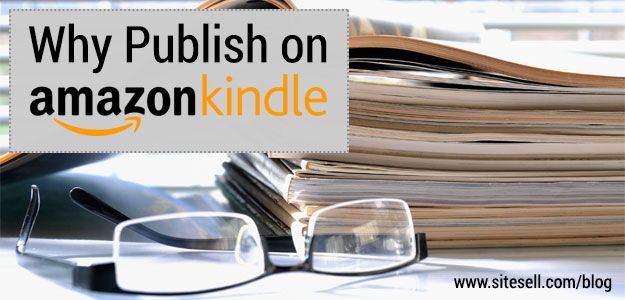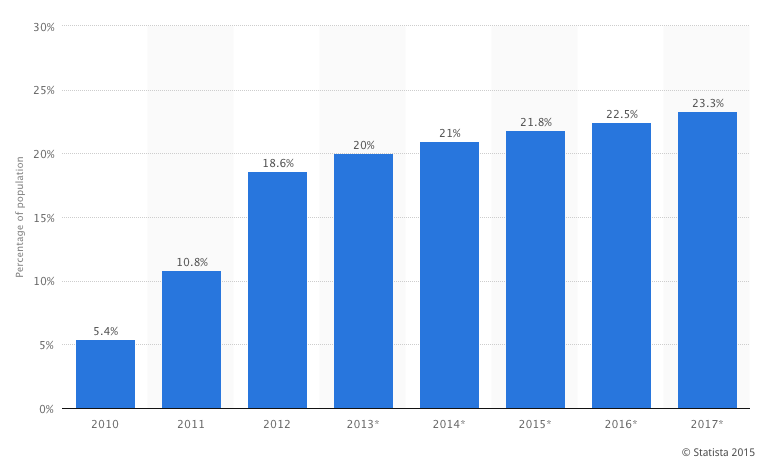Sales of e-reading devices have boomed in recent years. As the graph below shows, ownership of dedicated e-readers (like Kindles) have risen dramatically in the U.S. in the last five years…
Add to that the following facts…
- Amazon’s share of the e-book market is currently around 65%
- Sales of Kindle books at Amazon overtook physical book sales for the first time in 2011
…and it’s clear that Amazon’s Kindle Store represents a huge opportunity for anyone with an e-book to sell.
(Source: Statista.com)
Apart from the fact that the Kindle book market is huge (and that you want a piece of that pie for yourself), what are the specific advantages to publishing an e-book at Amazon? Here are two of them…
- First, and most obviously, the Kindle Store is a great way to monetize.
- Second, it’s an effective way to diversify beyond Google Search and drive new traffic to your site.
Let’s deal with the obvious advantage first…
1. Publish on Kindle To Make Money
AdSense and affiliate programs are both easy ways to monetize a website, but they come with a downside: you will almost certainly leave a lot of money on the table. “Active” monetization streams (such as selling a proprietary book) will increase your “dollar per visitor” ratio, perhaps dramatically.
Once you have decided that selling an e-book is right for you, the question becomes…
Where should you sell it?
Why sell a Kindle e-book through Amazon when you can just as easily sell a PDF version of the book through your site?
The best answer to that is that many people visit Amazon directly with the specific intention of purchasing an e-book. In other words, why restrict your market to people who discover you through the search engines or social media, when you can also sell your products through a thriving online marketplace for e-books? (More on decreasing your reliance on the search engines in a moment.)
Other advantages to publishing in the Kindle Store include…
- Selling an e-book through the largest online retailer arguably makes the e-book more credible than a PDF version sold from your site.
- It is easier for Amazon customers to purchase your book through Amazon’s checkout (possibly “one click” easy) than for customers to purchase through your website.
- You don’t need to worry about payment processing, product delivery and customer support… Amazon handles everything.
The biggest disadvantage to selling through Amazon, compared to selling through your site, is that you will make less profit per book. Why?…
- First, your royalty will be smaller (no more than 70%… compared to near-100% for PDF e-books). But when you consider everything that you get from Amazon (free traffic, everything handled for you) you might consider the lower royalty to be more than worth it.
- Second, the price of the book will probably be lower. Amazon encourages pricing in the $2.99 – $9.99 range by offering a higher royalty (if you price your book lower or higher, the royalty drops from 70% to 35%). In other words, selling a $20 Kindle book is pointless. But remember that what you lose in profit-per-unit you might more than make up for in higher overall revenue (because you sell more units).
Can you sell the same book as a PDF from your site and as a Kindle book?
Absolutely. Although you can’t enroll in the “KDP Select” program without granting exclusivity to Amazon (more on that later in this series). Another issue is price…
PDF e-books have traditionally commanded a double-digit price tag ($27 is a popular pricing point). Kindle books are generally priced under $10.
- Could you charge $27 for the PDF and $9.99 for the Kindle book? How would you justify the difference?
- If you charge $9.99 for both versions, why not sell through Amazon exclusively and leave it to Amazon to handle payment and delivery and deal with customers?
- With the recent growth in e-reader sales and inexpensive e-books, is there still a market for pricey PDFs?
Only you can decide on the answers to these questions.
Now for the second advantage…
2. Publish on Kindle To Drive New Traffic to Your Site
Monetize comes at the end of the Content > Traffic > PREsell > Monetize process for good reason…
- With no PREsell before it, the chances of “closing the deal” are drastically reduced. Unless you happen to already be a big, trusted brand (like Amazon), people are likely to resist your sales efforts.
- With no Traffic before the PREselling, you don’t even get the opportunity to build trust and credibility with PRE-customers. Your store, so to speak, is empty.
- And that’s why Content is so important. High-quality content (whether it be text or videos or images… or even tweets) supplies you with a never-ending stream of free and targeted traffic through search and social channels.
Selling a $9.99 Kindle book is a perfect example of this process in motion: Visitors arrive at your site and are “warmed up” by your personality-filled content. When you recommend your Kindle book, they click through to Amazon and buy it.
The process works perfectly for visitors who go online to search for information. But what about targeting people who specifically go online to purchase products (in our case, Kindle books… but it could equally apply to eBay or Etsy products)?
Does selling e-books to strangers fit into the C > T > P > M process? Or is it a case of putting the monetization cart before the horse?
It all depends on the type of e-book that you sell…
A 200+ page Kindle book selling for $9.99 is likely to be very much geared towards monetization. Your primary goal will be to make money from it.
A 50-page book selling for 99 cents (the minimum allowed) is more likely to be about driving traffic to your site. In short, the book changes from “M” to “C”… or from a way to monetize to a new form of content.
Let’s say that this 99c Kindle book is a mini-version of your site… or a “Quick Guide” to your site’s topic…
- You will make a few cents for every copy sold, but its main purpose is to act as Content. Amazon users visit the site to buy and read books… your book becomes one of them.
- Assuming that you optimize your book listing correctly, the Amazon search engine sends free and targeted Traffic to your book’s sales page…
- And the book itself PREsells readers to you and your “brand of one.” First, they visit your site (because, naturally, you link to it from your e-book). They probably sign up for your e-zine, too. And then…
- You Monetize these visitors. You sell them your online course or your $9.99 Kindle book.
In short, selling a cheap Kindle book fits into the Content > Traffic > PREsell > Monetize process perfectly.
You simply target a different subset of people (i.e., Amazon shoppers vs. Google/Bing searchers). And, in so doing, you decrease your reliance on Google.
Having said that, it’s important to keep Amazon’s potential as a traffic referrer in perspective. Search engine traffic will continue to be the most important traffic source for the foreseeable future. And also remember this…
Kindle publishing success stories (like Amanda Hocking) are the exception, not the rule. They are publishing’s version of lottery millionaires.
Nevertheless, Amazon does have excellent potential… both as a way to make money and as a way to drive traffic to your business.
If driving traffic is your primary objective, consider putting together a slim (but high-quality) e-book and selling it for as low as you are willing to go.
If making money is more important to you, sell your book for as much as you think it’s worth. And remember this…
Even an expensive book will still attract visitors that you would never have found through the search engines or social media… and you will still be able to refer these visitors back to your site, from where you can continue to make money from them in the future.
Publishing on Kindle Is Easy!
Whether you use the Kindle Store to make money from your existing visitors, or to find a new source of visitors to send back to your site (or both), the good news is that there is nothing difficult about the publishing process.
It all happens at Kindle Direct Publishing, and the help and guidance there is generally very good.
But for a far more comprehensive guide to how to publish on Kindle (including many tips you won’t find at Amazon), subscribe to the SiteSell Newsletter for future articles in this series.


Latest posts by SiteSell (see all)
- You’ve Written an Ebook – Now What? - August 17, 2015
- The Only Five Ways to Monetize Your Audience (Plus One Armageddon Option) - August 7, 2015
- Why Publish on Kindle? - June 19, 2015



